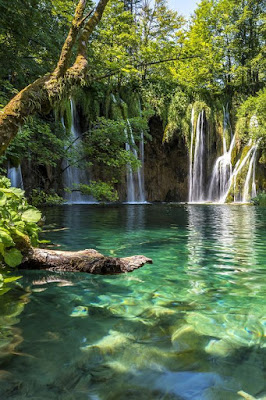CAUSE AND EFFECT GLOBAL WARMING
“CAUSE AND EFFECT GLOBAL WARMING ”
What causes Global Warming?
Earth's average temperature has almost doubled from 50 years ago. The increase in temperature is more or less happened following the natural geographical cycle of the earth. However, extreme changes that occur very quickly can not be justified by that reason alone. The scientists conclude that the main cause of global warming is carbon dioxide gas emissions as a greenhouse effect (ERK) from human activities. The true greenhouse effect is a natural process that should make the Earth a comfortable place to live.
ERK occurs when a blanket of atmospheric gas traps some of the sun's heat, making the Earth a warm and habitable planet. During the daytime, sunlight will penetrate the atmosphere to warm the Earth before it finally cools down at night. However, this temperature drop is not drastic because some of the heat remains trapped in the atmosphere.
The energy absorbed by the atmosphere will keep the temperature of the Earth warm. Without the protection of the atmosphere, the Earth could not be inhabited by living creatures because it was so cold. Even so, human activities such as the use of fossil fuels (coal, oil, and natural gas) actually increase the amount of hot gas released into the air thereby changing the principle of the natural greenhouse effect of the Earth. The more hot gas produced by humans, the more heat is trapped by the atmosphere to be reflected back to earth. This is a major problem that contributes to global warming.
What human activities cause global warming? Global warming occurs when gases resulting from the greenhouse effect such as carbon dioxide (CO2) and other air pollutants are absorbed by the atmosphere and reflected back to the earth's surface. Here are xx human activities that are the main causes of global warming.
1. Deforestation (deforestation) Millions of hectares of forests in various parts of the world are cut down every year for commercial purposes, such as for making paper and furniture. Forests are also cut down to open agricultural land and livestock, or to open roads for housing and industrial areas. Land clearing is not only done through logging. Not infrequently, rogue industrial elements deliberately burn forests in order to more quickly clear land. Burning forests will certainly raise the average temperature in the area while also releasing carbon dioxide and other pollutants in larger portions. In fact, plants and trees play a big role in balancing the greenhouse effect by absorbing more carbon dioxide and preventing it from being trapped in the atmosphere. Plants will release oxygen to help neutralize the heating temperature of the earth. The less forest land available, the more likely the quality of oxygen on earth will deteriorate. Deforestation also destroys habitats that can threaten biodiversity.
2. Vehicle fuel gas emissions Motor vehicle exhaust emissions are the biggest responsible for global warming. More than 90 percent of public transportation (whether land, air or water) is powered by petroleum fuels, such as gasoline or diesel. The gas released from this combustion process releases carbon dioxide and other pollutants, such as methane and nitrous oxide. Every gallon of gasoline you use to ride a car or motorbike everyday can contribute 10 kilograms of carbon dioxide to the Earth's atmosphere. Worse yet, each type of pollutant gas has the ability to trap heat differently. Some can even trap more heat than carbon dioxide. The methane molecule, for example, cannot last long in the air like CO2 but is able to bind to heat 84 times faster and much more. Nitrous oxide is even 264 times stronger than CO2. Some of this gas will gradually damage the quality of air, soil and water.
3. Agricultural and livestock waste The role of the livestock and agricultural industries in the increasingly severe global warming must not be underestimated. Apart from the effects of deforestation, waste produced from fertilizers and animal dung also produces harmful gas emissions. Breathing, gas, and manure, especially cattle and buffalo, produce methane, which is a type of greenhouse gas. Compost made from animal dung also produces nitrous oxide gas. Agriculture industry waste accounts for 9% of the total volume of greenhouse gas emissions generated in 2017.
4. Electricity usage Petroleum, natural gas and coal power plants are by far the second largest emitters of greenhouse gases after the manufacturing industry. In the United States, burning coal for electricity generation generates about two billion tons of CO2 waste each year. Wasteful use of electricity accounts for 27.5 percent of total greenhouse gas emissions in 2017.
What are the effects of Global Warming?
“THE IMPACT OF GLOBAL WARMING FOR HUMAN LIFE AND THE ENVIRONMENT”
List of global warming impacts
1. The effects of global warming which are quite often published are melting glaciers: Melting glaciers will create many problems for humans and animals that live on earth. One of them is sea level rise. As global warming increases, sea level will rise, potentially causing flooding.
2. The second result of global warming is climate change. Irregular weather patterns have begun to show the effects of global warming. Increased rainfall in the form of rainfall has been known in the polar and desert regions. Increased global warming will cause more evaporation which will cause more rain. Animals and plants cannot easily adapt to increased rainfall. Plants can die and animals can migrate to other areas. This can cause the entire ecosystem to change totally and quickly. Beyond human ability to adapt.
3. Increased and widespread drought. Despite the possible rain and floods in Savannah, severe drought has occurred in other parts of the world. When temperatures are warm, the existence of drought has increased in the western United States. Drought also causes forest fires in Indonesia. Large-scale evaporation is a major cause of drought in many places, especially Africa. Potential drought causing crop failure can cause malnutrition.
4. Widespread disease. Because the earth's temperature becomes warmer, this can affect human health and the spread of the disease they face. With increased rainfall, water-borne diseases tend to spread, such as malaria.
5. Increased frequency of storms. When ocean temperatures rise, hurricanes and other storms tend to get stronger. With increasing global warming, the water in the ocean heats up which will heat the surrounding air, creating hurricanes.
6. Sea level rise. The melting of the polar ice caps and the reduction in water that evaporates into the atmosphere causes sea levels to rise. Cities and coastal cities not far near the US east coast, the Pacific islands, the Gulf of Mexico are just a few areas where flood damage has begun to drown some of its area.
7. Global warming can affect agriculture. When global temperatures will rise, plants will find it more difficult to survive and will die. Plants are the main source of food for humans and as a result food shortages can occur. Food shortages can cause war and conflict in some countries.
8. Heat Waves. Heat waves cause dangerous hot weather and in recent years, more deaths have occurred due to heat waves than in the past sixty years, such as a heat wave that occurred in India recently, as reported by The Gurdian.
9. The next impact of global warming is the occurrence of forest fires. Although forest fires are a natural occurrence, increasing carbon dioxide in the air and hotter summers makes forest fires easier and more frequent. Forest fires are more frequently occurring in large numbers each year, such as in Indonesia, Australia and America. The rate of combustion is longer than the last, and with the release of carbon dioxide into the air, not only are the lives of people in danger, but wildlife is suffering. Every time a fire burns, less oxygen is available to counter the dangerous amount of carbon dioxide being released into the atmosphere.
10. Seasonal changes take the form of longer or shorter season periods. Changes in the season, for example spring, fall, rain, can occur faster and faster, or longer and longer.
11. Impact on plants. The occurrence of seasonal changes causes weather patterns to be erratic and extreme. Flooding due to rising sea levels, crop failure, changes in the spring season increase the risk of crop failure to bear fruit and be harvested. This will have a negative impact on the food industry. The price of staple crops can increase dramatically. In the end it will cause a decline in economic performance.
12. Damage to the marine ecosystem. The condition of the world's coral reefs continues to diminish and is damaged by global warming. Once a coral reef is affected, all developing ecosystems become obsolete, including a decline in the fisheries sector.
13. Food chains in the ecosystem. Changing the time pattern and duration of migratory bird migration, hibernation takes longer. As a result, the entire food chain can be disrupted.
14. Increased health risks. With the increasing amount of carbon dioxide trapped in the atmosphere, the quality of air for breathing is getting worse and harder to obtain. If global warming continues, according to one estimate, the US will spend about 60 billion dollars to combat respiratory illnesses and symptoms.
15. Animal extinction. Global warming increases the risk of animal extinction. The occurrence of global warming caused some animals to change their habitat so that they migrate. This migration will cause some animals to not be able to adapt. For example, migrating white foxes are unable to compete with red foxes, as published by the BBC article titled "Arctic foxes suffer while red thrive in northern Canada".
Those are some of the effects of global warming for humans, animals and plants that have been identified and must be known. By knowing the effects of global warming, hopefully we can better manage our environment.



Komentar
Posting Komentar